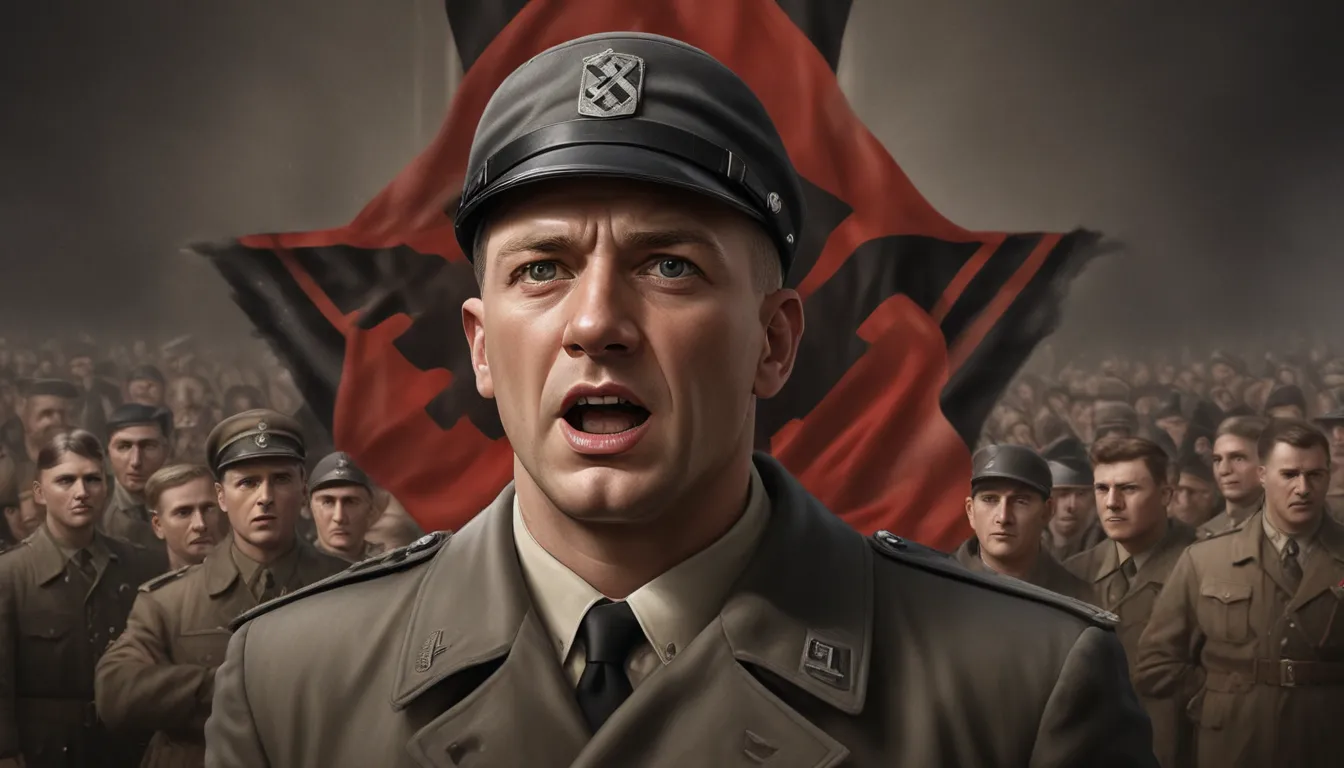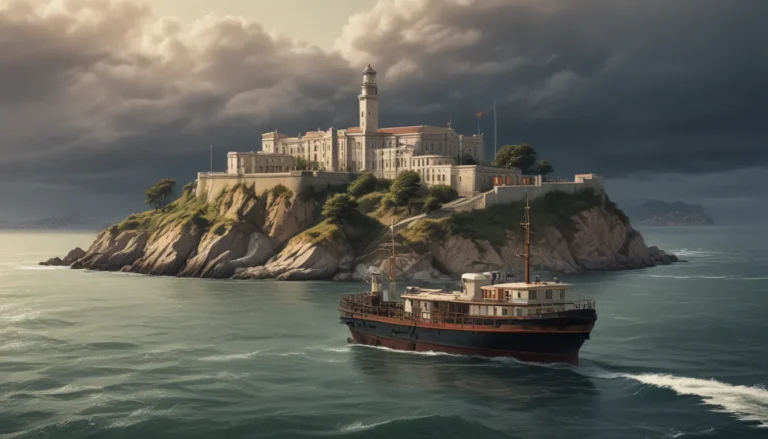The images in our articles may not match the content exactly. They are used to grab your attention, not to show the exact details in the text. The images complement the text but do not replace it.
When we think of the Nazi Party, Adolf Hitler, and the atrocities of the past, a wave of horror and darkness engulfs our minds. The history of the Nazi Party is a grim chapter in our past, stained with terror and suffering. In this detailed exploration of Nazi Party facts, we delve into the origins, ideology, and impact of one of the most notorious political movements in history.
Unraveling the Roots of Nazism
To truly understand the Nazi Party and its actions, we must first grasp the foundation on which it was built. Nazism, officially known as National Socialism, was the guiding ideology of Adolf Hitler and the Nazi Party in Germany. Characterized by fascist principles, Nazism rejected parliamentary systems and liberal democracy. Central to its creed were elements of scientific racism, anti-communism, and eugenics.
Inside the Nazi Party: The Life of a “Nazi”
The term “Nazi” is an informal abbreviation for a member of the Nazi Party, derived from “Nationalsozialisten”. Originally, the term carried connotations of clumsiness or backwardness. However, as the party gained power, its members adopted the term as a colloquial identifier. The transformation of this once-mundane term into a symbol of terror reflects the profound impact of the Nazi Party on history.
The Dark Shadow of the Holocaust: Nazi Party’s Legacy of Death
One of the most haunting legacies of the Nazi Party is the Holocaust, a systematic genocide that resulted in the deaths of millions. Targeting Jews, individuals with disabilities, and other marginalized groups, the Holocaust embodied the Nazis’ twisted vision of a racially pure society. The term “Holocaust” itself, derived from the Greek “holokauston,” evokes the horrific scale of sacrifice by fire that characterized this atrocity.
The Early Beginnings of Jewish Persecution
Contrary to popular belief, the persecution of Jews by the Nazi Party did not begin with the outbreak of World War II. As early as 1933, when Hitler ascended to power, Jews in Germany faced discrimination and violence. While the intensity of persecution escalated from 1941 onwards, the seeds of Jew suffering were sown well before.
Unveiling the Emblem of Hate: The Swastika
The swastika, a symbol synonymous with the Nazi Party, served as its principal emblem. Adopted in the 1920s, the black swastika on a red, white, and black background became the party’s insignia. Symbolizing the party’s social, national, and ideological mission, the swastika remains a stark reminder of the dark chapter in history.
The Propaganda Propagator: Joseph Goebbels
At the helm of Nazi propaganda was Joseph Goebbels, the Reich Minister of Propaganda and a devoted confidant of Hitler. Known for his anti-Semitic rhetoric and skill in public speaking, Goebbels played a pivotal role in shaping public opinion and spreading Nazi ideology. His tragic end, marked by suicide following Hitler’s death, underscores the fanatical devotion of Nazi Party members.
The Paradox of Compassion: Nazi Party’s Animal Protection Laws
Surprisingly, amidst the cruelty and violence of the Nazi regime, Hitler enacted comprehensive animal protection laws in 1933. These laws reflected Hitler’s aversion to animal cruelty, signaling a paradoxical facet of the Nazi Party’s ideology. In a regime marked by brutality, these laws offered a glimpse of compassion amidst the darkness.
Shadows of Complicity: The Jewish Chauffeur of Hitler
In a poignant twist of fate, Adolf Hitler, the architect of Jewish persecution, unwittingly employed a Jewish chauffeur, Emil Maurice. Despite the regime’s anti-Semitic principles, Hitler granted Maurice and his brothers honorary Aryan status, sparing them from the regime’s harsh policies. This paradox sheds light on the complexities and contradictions within the Nazi Party.
Legacy of Infamy: Rudolf Hess and the Nazi Aftermath
Rudolf Hess, a prominent figure in the Nazi Party and Hitler’s Deputy Führer, faced a different fate after the war. Sentenced to life imprisonment following Hitler’s death, Hess spent decades in prison before his mysterious death at the age of 93. His enigmatic end encapsulates the lingering shadows of the Nazi Party’s dark reign.
The Brownshirts: Enforcers of Terror
The Sturmabteilung, or Brownshirts, served as the paramilitary wing of the Nazi Party, enforcing terror and violence against Jews and leftists in pre-World War II Germany. Operating outside the bounds of the law, the Brownshirts embodied the vigilante spirit of the Nazi Party, instilling fear and intimidation among dissenting voices.
Birth of the SA: Hitler’s Private Army
In the early days of the Nazi Party, Adolf Hitler established the Sturmabteilung, or SA, as a private army composed of anti-democratic and anti-leftist ex-soldiers. Used to intimidate political opponents and assert dominance, the SA played a pivotal role in Hitler’s rise to power. Despite their early role as enforcers, their notoriety as bullies would be scrutinized in later years.
Architect of Power: Albert Speer and Nazi Germany
Among the diverse professions within the Nazi Party was architect Albert Speer, who became Minister of War Production during World War II. A close ally of Hitler, Speer played a critical role in the regime’s war efforts before facing imprisonment post-war. His story underscores the varied talents enlisted in service of the Nazi Party’s destructive agenda.
Martyrdom and Myth: Horst Wessel’s Legacy
Horst Wessel, a member of the Brownshirts, was immortalized as a martyr following his murder by communists in 1930. Joseph Goebbels leveraged Wessel’s death to propel Nazi propaganda, cementing his status as a martyr for the Nazi cause. Wessel’s tragic fate underscores the cult of heroism cultivated by the Nazi Party.
Propagandist Par Excellence: Julius Streicher and Der Stürmer
As a member of Germany’s national legislature and Franconia’s regional leader, Julius Streicher wielded considerable influence as the founder and publisher of Der Stürmer, an anti-Semitic newspaper. Central to the Nazi Party’s propaganda machine, Streicher played a pivotal role in disseminating anti-Semitic rhetoric. His eventual sentencing to death following the war highlights the culpability of Nazi Party members in perpetuating hate.
Ideological Architect: Alfred Rosenberg and Nazi Doctrine
Alfred Rosenberg, a key figure in the Nazi government, shaped the ideological underpinnings of the party with his racial theories and anti-Semitic beliefs. His influence extended to policies such as the persecution of Jews and the rejection of the Treaty of Versailles. Rosenberg’s doctrines laid the groundwork for the genocidal actions undertaken by the Nazi regime.
Nuremberg Laws and the Stripping of Rights
The enactment of the Nuremberg Laws in 1935 stripped Jewish people of their rights and standing within German society. With laws such as the Protection of German Blood Law, the Nazis sought to enforce their vision of a racially pure state, excluding Jews and other marginalized groups. These laws laid the groundwork for the systematic discrimination and persecution that defined the Nazi Party’s rule.
Night of Broken Glass: The Kristallnacht Pogrom
The Kristallnacht, or Night of Broken Glass, unfolded on November 9, 1938, as Nazis orchestrated attacks on Jewish-owned businesses and individuals across Germany and Austria. With thousands of Jews subjected to violence and arrest, the Kristallnacht marked a turning point in the escalation of anti-Semitic persecution under the Nazi Party.
Dark Legacy of Mass Incarceration
In their ruthless quest for racial purity, the Nazis erected over 44,000 incarceration sites, comprising forced labor camps, detention centers, and killing facilities. Within these sites, victims endured starvation, torture, and mass murder, bearing witness to the depths of cruelty unleashed by the Nazi Party. The sheer scale of these facilities reflects the chilling reality of the Nazi regime’s atrocities.
Beyond the Holocaust: The Vast Scope of Nazi Atrocities
While the Holocaust claimed millions of lives, the victims of Nazi brutality extended beyond the Jewish population. Queer individuals, Jehovah’s Witnesses, and those with disabilities or deformities also faced persecution and death at the hands of the Nazi Party. The staggering toll of lives lost underlines the far-reaching impact of Nazi atrocities.
A Dropout’s Ascent: The Path to Power of Adolf Hitler
Adolf Hitler, the leader of the Nazi Party, defied conventional expectations with his humble beginnings as a school dropout. His journey from obscurity to infamy reveals the complex interplay of personal ambition and historical circumstances that catapulted him to power. Hitler’s rise serves as a cautionary tale of the dangers of unchecked authority and unchecked ambition.
The Last Stand: Volkssturm and Nazi Defiance
Amid the waning days of World War II, the Nazis mobilized the Volkssturm, a national militia comprised of men aged 16 to 60 who were not serving in the military. This desperate measure aimed to bolster German resistance against advancing forces through sheer force of will. The formation of the Volkssturm symbolized the Nazi Party’s final stand against the tide of defeat.
Lingering Shadows: Karl Dönitz and Post-War Reckoning
After Hitler’s death, Karl Dönitz assumed leadership as Germany’s Head of State in 1945, marking a continuation of the Nazi regime in its twilight hours. Despite his prior role as a respected admiral, Dönitz faced a post-war trial and eventual imprisonment for his involvement in war crimes and violations of international law. His fate underscores the enduring legacy of Nazi complicity in the aftermath of the war.
The Grim Harbinger: The Execution of Joachim von Ribbentrop
In the aftermath of the war, justice was meted out to prominent Nazi figures, including Joachim von Ribbentrop, the Minister of Foreign Affairs under Hitler. Initially hailed for his worldly expertise, Ribbentrop’s complicity in Nazi atrocities led to his conviction and subsequent execution by hanging in 1946. His fate epitomizes the reckoning that awaited those responsible for the horrors of the Nazi regime.
Birth of Terror: The SS and Nazi Parliamentary Organization
At the core of the Nazi Party’s parliamentary organization was the Schutzstaffel, or SS, initially a guard unit comprising Nazi volunteers. Evolving into a formidable force of surveillance and intimidation, the SS became one of the most potent symbols of Nazi terror in Germany and occupied Europe. Their reign of fear reflected the ruthless enforcement of Nazi ideology.
Architect of Death: Reinhard Heydrich and the Holocaust
Instrumental in orchestrating the Holocaust was Reinhard Heydrich, a high-ranking SS official and chief officer of the Reich Main Security Office. Heydrich’s role as the primary architect of the Holocaust underscored the calculated brutality of the Nazi regime, culminating in his assassination by resistance fighters. His legacy of terror and death casts a haunting shadow over the Nazi Party’s history.
Racial Dominion: The Vision of the Nazi Party
Central to the Nazi Party’s agenda was the establishment of a new racial order, epitomized by the dominance of the German Master Race across Europe. Hitler’s vision of a racially homogenous society guided Nazi foreign policy and territorial expansion, resulting in catastrophic consequences for millions. The Nazi Party’s ultimate goal of racial supremacy left an indelible mark on history.
Youth Enslaved: The Hitler Youth
Adolf Hitler’s militarized youth organization, the Hitler Youth, indoctrinated young Germans into loyal service of the Nazi Party. Led by Baldur von Schirach, the Hitler Youth played a key role in deporting Jews and enforcing Nazi policies. Faced with a stark choice between compliance and execution, Hitler Youth members embodied the tragic consequences of unchecked indoctrination.
Gauleiters: Regional Enforcers of Nazi Rule
Overseeing the enforcement of Nazi policies were Gauleiters, regional leaders appointed directly by Adolf Hitler. Holding significant sway within the party hierarchy, Gauleiters wielded immense power second only to the Führer himself. Their role in enforcing Nazi ideology at the grassroots level underscored the pervasive reach of the Nazi Party’s authoritarian regime.
Echoes of Justice: Nuremberg Trials and Accountability
In the aftermath of the war, the Nuremberg Trials sought to hold Nazi leaders accountable for their crimes against humanity. With 24 Nazi officials facing charges, the trials aimed to bring a measure of justice to the victims of Nazi atrocities. While unable to reverse the horrors of the past, the trials served as a beacon of hope for a world scarred by the specter of Nazi terror.
Conclusion: Remembering the Lessons of History
As we reflect on the Nazi Party’s dark legacy, it is imperative to heed the lessons of history. The horrors unleashed by the Nazis serve as a stark reminder of the dangers of totalitarianism, xenophobia, and unchecked power. By confronting the truth of the past, we honor the memory of the victims and reaffirm our commitment to a future rooted in tolerance, justice, and humanity.
Through these in-depth explorations of Nazi Party facts, we illuminate the complexities and tragedies of a dark chapter in human history. May the voices of the past echo through time, reminding us of the enduring importance of vigilance, empathy, and remembrance in safeguarding against the shadows of tyranny.






